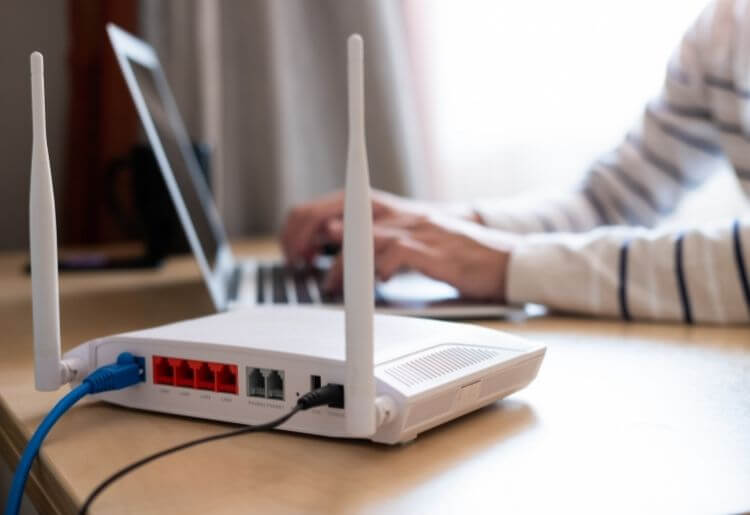One way to take back control is to confirm you’re signed up with any of the best internet service providers (ISPs). You’ll also want to be on a plan best suited to your speed requirements. If you’re keen to learn other ways to a quicker browsing experience, read our top 10 tips for how to speed up your internet connection.
1. Troubleshoot Your Computer
Your speed problem may not be ISP-related but rather an issue with your computer. For example, pending downloads or software updates could be running in the background. To review any processes affecting performance, open your operating system Task Manager. Here you can pinpoint possible issues and close any problematic tasks.
If you have lots of tabs open in your browser, some may be streaming audio or video without your knowledge. This could use a lot of bandwidth, so be sure to close these. Best to close any other unnecessary pages as well. Clear your browser cache and history to remove temporary files, and you’ll gain faster page loading and improved performance.
Installing an ad blocker will prevent any ads from using up your internet. You can also restrict ad-targeting cookies stored on your machine by updating browser settings and computer configuration. If you’re still not sure what could be wrong, restart your computer to refresh the system and fix possible underlying issues.
2. Upgrade the Router and its Firmware
Older routers and those with outdated firmware can result in dropped connections and security issues. While a new router may be expensive, it will deliver dual-band signal spectrums (2.4GHz and 5GHz) for speedier and more stable connections. The upgrade may also offer improved security features. You can check the router’s firmware, and update it yourself or contact your ISP to update it remotely.
3. Reset the Router
Performing a hard reset or router shutdown may fix issues in the firmware affecting your internet speed. The reset will refresh your router’s link with the ISP and select a new and less crowded frequency. For convenience, consider getting a programmable timer to reset your router at specific intervals. This will save you needing to remind yourself to do it.
4. Place the Router in a Good Position
Even the best router in the world will struggle to offer a reliable signal if placed in the wrong spot. Find a central and raised area, away from thick, obstructive walls and objects. Don’t place it in drawers or closets, or near windows where the signal may exit to the outdoors.
To prevent signal interference, place the router far from kitchen appliances and other smart devices. Ensure any router antennas are facing the direction in which you’ll be using your devices. Network extenders and boosters may also help to strengthen your signal. These can bring coverage to dead spots, remove buffering or lag, and improve internet speeds.

5. Confirm Whether Someone is Stealing Your WiFi
Sometimes, your slow internet speed is due to someone stealing your WiFi. If you still have lag after making the above changes, it’s worth checking whether you have an unauthorized visitor on your home network.
First, visit speedtest.net to compare your current speed to your expected ISP plan speed. Next, disconnect all your devices and locate the Wireless Local Area Network (WLAN) indicator light on the router. If this light is flashing, it indicates there’s someone else connected to your internet. You can also analyze your bills at the end of the month to confirm if you’re using more bandwidth than usual. Excess billing could be a sign of an intruder on your network.
If you detect foul play, you’ll want to set up a new, strong WiFi password. Make sure to use eight or more characters, mixing uppercase and lowercase letters, numbers, and special symbols.
6. Resolve Issues Affecting Bandwidth
You may suffer from slow internet speeds when connecting multiple devices. For instance, one device streaming videos will tend to take up more bandwidth than others. Your download speeds for all devices can then drop, and you may be unable to achieve expected speeds.
To free up additional bandwidth, consider limiting internet access to younger children in the evenings. You could also restrict bandwidth per activity, setting limits for video conferencing, music streaming, and so on. Xfinity Internet works well for families and multiple connections, but you may still need to manage access to prevent slow speeds.
Viruses and malware may affect your internet speeds by siphoning off your bandwidth. You should install antivirus software to keep these nasties at bay. A virtual private network (VPN) can help keep your browsing private, but it may also result in slower speeds.
Look out for any unused devices still connected to your router, as these can pool your bandwidth. You’re best to switch these off if they’re not needed. According to Verizon, older devices on your network can significantly slow down your network speeds.
7. Connect Using Ethernet Cables
If you want speed, it’s best to connect some of your devices to your router directly using an Ethernet cable. WiFi connections offer convenience and mobility, whereas Ethernet connections are stable and reliable. For example, a gaming console connected by Ethernet will ensure you won’t disconnect mid-game.
Verizon 5G Home suits gamers and stream hogs, but you should connect your console directly if you want faster speeds and less lag. This applies to smart TVs, desktop computers, and any devices placed close enough to connect an Ethernet cable.
8. Check for a Data Cap
Your ISP may not mention it, and it may not be openly listed, but there’s often a monthly data cap for broadband plans. A data cap is the set amount of data you can use during your monthly subscription. Once you exceed the cap for your plan, you’ll experience lower speeds. The ISP may even charge you for any additional data you use.
Ask your ISP about data caps before you subscribe. Be clear on whether you want unlimited data, as this will guide you when selecting a plan. Once you sign up for a subscription, check your bill every month to see if there are extra charges. If your data cap is fine but you’re still getting slow speeds, request your ISP to send a technician to find out what’s wrong.
9. Subscribe to Plans Offering Higher Speeds
If the speed on your home network is not meeting your expectations, it may be time for an upgrade. If the issue is not hardware or software related, it could just be that the plan is not suitable for your needs. For instance, lower speed plans only offer standard definition (SD) videos, but you may be after high definition (HD) streaming.
The Federal Communications Commission (FCC) provides a free search tool, highlighting ISPs in your area and their maximum speeds offered. Each ISP has many features that may suit your needs, such as faster speeds to load web pages quickly or stream videos seamlessly.
10. Change Your Internet Service Provider
When all else fails, consider switching your ISP to get efficient service, reliable internet, and faster speeds. Poor customer service agents may prolong your suffering by not caring why your speed is slow. Some unscrupulous customer service agents even claim they’ve fixed the issue, when nothing has actually changed!
To find a trustworthy ISP with fast speeds, check customer reviews and visit the Better Business Bureau (BBB). Talk to friends and neighbors to learn their preferred internet provider. Call customer service to get a feel for how they’ll treat you once you become a customer.
Conclusion
It may take time to pinpoint what’s slowing down your internet, but the above tips will help for starters. Make sure to place your router away from obstructions, and upgrade your old devices to improve connections and security.
Check your computer for any causes of slowdown, and restart to refresh its operations. Scan your network to remove bandwidth leeches, and manage internet access to limit congestion on your WiFi. Connect to the router using Ethernet cables for faster connections.
Fast internet speeds are essential for an excellent browsing experience. This means it’s vital to find an ISP offering high-speed plans, reliable connections, and considerate customer service.
